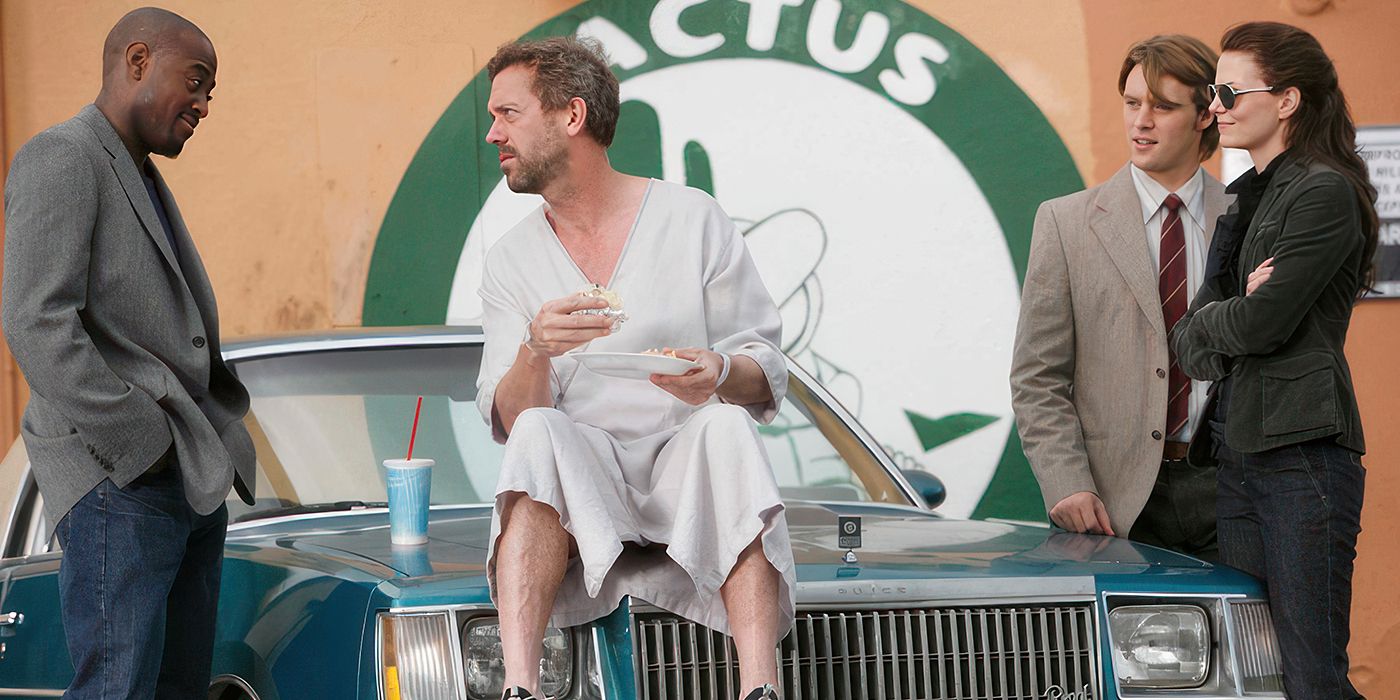Now, over 20 years after it first aired, House is still one of the most creative and unique medical dramas. The series follows Dr. Greg House (Hugh Laurie), the head of the Department of Diagnostic Medicine at Princeton Plainsboro Teaching Hospital. House is too blunt and doesn’t play by the rules, but he is also the best at what he does, and there is no problem that he can’t diagnose. This character is the driving force of what makes the series so memorable, but House also has a number of innovative episodes that subvert the structure of a typical medical drama.
Many of House‘s very best episodes, including “No Reason” and “House’s Head,” depict House struggling to distinguish between what is real and what is in his mind. House is particularly skilled at episodes that paint House as an unreliable narrator to shake up the story structure. While a number of House’s best episodes do this, it all started back with Season 1, Episode 21, “Three Stories.” This is the first episode of the show that utilizes House as an unreliable narrator, and many of House‘s best episodes later in the show continued to employ the “Three Stories” structure.
‘House’ Subverted Expectations With Its Major Plot Twist
In “Three Stories,” House reluctantly gives a lecture to a class of med students after Cuddy (Lisa Edelstein) asks him to fill in for their sick professor. While going to the lecture, House runs into his ex-girlfriend, Stacy (Sela Ward), in her first appearance on the show. Stacy asks House to take on her husband, Mark (Currie Graham), as a patient, but House refuses. He then tells his students about three different patients that he allegedly treated who were all at risk of losing a leg: a farmer with a bad bite, a teenage volleyball player who fainted without a clear cause, and a third patient who experienced extreme leg pain while playing golf. House’s narrative is intentionally unreliable, as he regularly changes the identity of each patient, and even occasionally swaps each of them out for Carmen Electra.
As “Three Stories” continues, each of the three cases becomes more fleshed out. It turns out that the farmer was actually bitten by his dog instead of a snake, and that he’d been lying to the doctors to protect his dog. The volleyball player ultimately had a tumor in her leg, and recovered just fine. The big twist of the episode is that the third patient is actually House five years earlier. After seeing Stacy, House thinks back on the loss of his leg, and he tells the story while hiding his identity. He describes going to the hospital for leg pain, and the doctors believing that he was faking to get drugs. House then reveals that he had an infarction in his leg. House had been dating Stacy at the time, and the two disagreed about the form of treatment to take. House wanted to preserve as much of his leg as possible, but Stacy went against his wishes and opted for the especially invasive surgery in order to save his life.

Related
The 8 Funniest Quotes From Hugh Laurie in ‘House,’ Ranked
House could be rude, condescending, and often unhinged, but man, was he witty.
Over the course of House‘s first season, House suffers from chronic leg pain, and he regularly treats himself with Vicodin. The source of House’s pain could have been revealed in a number of ways, but the show’s choice to reveal it through the lecture is especially powerful. It’s clear from the start of the lecture that House is intentionally altering the details in order to keep his students on their toes, but the reveal that the farmer is actually House hits like a ton of bricks. It is very fitting for House’s character to reveal something so vulnerable through a casual story to his students, particularly by hiding his identity and then trying to get their opinions on the matter.
Several of the Best Episodes of ‘House’ Followed the Structure of “Three Stories”
The structure of “Three Stories” influenced a number of House‘s best episodes, with the strongest examples being Season 2’s “No Reason” and Season 4’s “House’s Head.” In “No Reason,” House gets shot, and he ends up sharing a hospital room with Jack Moriarty (Elias Koteas), the man who shot him. While recovering from his gunshot wounds and dealing with the aftermath of a procedure that cured his leg pain, House tries to diagnose a patient with a swollen tongue. House realizes that he’s hallucinating after he has a conversation with the patient’s wife (Michelle Clunie), only to learn that the patient is a widower. Throughout the episode, House struggles to figure out when he’s hallucinating and when he’s not. His reality only becomes more distorted throughout, before it is then revealed that House has been hallucinating for the entire episode. House then comes only seconds after he’s been shot, and the episode ends.
“House’s Head” starts with House at a strip club with no memory of the past four hours. He then realizes that he was involved in a bus crash, but he can’t remember the details. House returns to Princeton Plainsboro, where he receives treatment for his injuries and attempts to piece together the missing part of the puzzle. Throughout the episode, House alternates between being present at the hospital and returning to the bus in his subconscious. House puts the details together enough to treat the bus driver, but he realizes that there is another missing piece. At the same time, House continues to see an unfamiliar woman in his mind on the bus. This all builds up to House’s realization that Amber (Anne Dudek) was on the bus, and that she is dying.
“No Reason” and House’s Head” amp up the unreliable narrator trope by messing with House’s perception of reality, so that he is unsure of what is real, and he finds out the truth alongside the viewers. Ultimately, though, both of these episodes build on what “Three Stories” already got right the first time. “Three Stories” has the perfect balance of a deeply emotional reveal and a shocking twist. Unlike the other two episodes, House is entirely in control of the narration in “Three Stories.” He is fully present and aware, but he chooses to distort the details and hide his identity in the story, so that he can work through the details of Stacy’s decision without tying it back to him. The result is a truly phenomenal episode of television that sets the bar very high for House.


